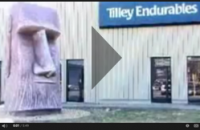Bartell Drugs ERP Case Study: Warehouse Management for Drugstores
 THE TOTAL RETAIL WAREHOUSE: DRUG STORE RETAILER SAVES MONEY AND IMPROVES CUSTOMER SERVICE LEVELS
THE TOTAL RETAIL WAREHOUSE: DRUG STORE RETAILER SAVES MONEY AND IMPROVES CUSTOMER SERVICE LEVELS
For a company that started out 118 years ago as a single-location pharmacy owned and run by an inexperienced 21-year old pharmacist from Kansas, Bartell Drugs has come a long way. Today, Bartell Drug Stores has 55 locations throughout Washington State and now sell a lot more than just your usual pharmacy fare.
Bartell has not only kept pace with the existing drug store chain trends to stock everything from pharmaceuticals, photographic equipment to groceries, but they have always – and will continue to – place a heavy emphasis on customer satisfaction and service. They consistently design their business plans and technology solutions so they reflect and can actualize these core values. This has made them a leader in their geographic market.
For most of the past 118 years, almost all products sold at Bartell Drug stores were brought in directly from suppliers. This arrangement did not allow Bartell to take advantage of the many benefits associated with supplying their stores from their own warehouse – a trend that heavyweights such as Wal-Mart have turned into almost standard industry practice.
When it came time to fundamentally change the way Bartell brought stock into their stores, they were apprehensive. Many peers’ warehouse technology installations had not been successful (an average of 50% of all implementations undertaken are not completed or not completed to the client’s satisfaction). Failure was not an option and Bartell was determined to maintain their business at optimum levels.
Bartell’s plan also called for the completion of a new state-of-the-art 161,280 square-foot complex that would stock and supply almost everything eventually sold in Bartell’s stores, including a large inventory of prescription drugs.
A consultant was retained to help Bartell management examine various warehouse management systems. Included in this review was a new entry in the market: Magstar Total Warehouse. Bartell had become very familiar with Magstar’s enterprise retail management solution, Magstar Total Retail as they had been using Total Retail since 1995. Magstar had proven they could provide excellent levels of 24/7/365 service, support and accuracy with their fully-synchronized, real-time solution. Magstar Total Retail has given Bartell a robust central data repository to handle all operating areas, including: financials, BI, accounts payable, purchasing, ordering, through to POS, merchandising and CRM, among others.
Magstar Total Warehouse’s package was attractive to Bartell because it would dovetail perfectly with the existing functionality in Total Retail. Staff training and use would be easy due to their familiarity with the interface. The project overhead usually associated with integrating two systems would be less. Finally, Magstar Total Warehouse was full featured yet would still save Bartell money when compared to other available standalone warehouse solutions.
Importantly, Magstar Total Warehouse would provide Bartell with the kind of leading-edge warehouse management solution they would need to not only ensure their high customer service levels were met, but to also help them as they expanded their operations in the future.
Bartell had many challenges to deal with that had to be met by their new warehouse solution.
Some of these were:
- The system had to run RF handheld units only, with minimal need for back-office (PC) usage and with absolutely no paper. In fact, they wanted to ensure that no warehouse floor personnel would ever need to use a PC. Only the warehouse manager would use a PC to run various managerial functions
- The solution had to capably handle more than one warehouse in the same database. This need evolved primarily from the fact that, for legal reasons, drug store stores and chains must physically and otherwise keep their inventory of prescription drugs separate from the rest of their stock.
- All inventory updates needed to be in real-time for qty-on-hand in the warehouse, as well as in individual stocking locations so they are always up-to-date. Thus, no scheduled or manual jobs could be required to make this happen.
- The new warehouse solution would have to support many different types of bin locations:
- flow racking for picking of individual selling units;
- regular storage locations for storing of single pallets of product; and
- bulk-storage locations for storing of multiple pallets of the same goods.
- Receiving against an electronic packing slip would be required (vs. receiving blindly) which would be delivered via EDI in order to reduce receiving errors.
- Due to limited floor space in the receiving area, they had to be able to receive pallets on a given incoming shipment and put them away before the rest of the pallets on the shipment had been even off -loaded from the trucks.
- Two different methods of picking needed to be supported: pick-to-belt and put-to-store. In pick-to-belt, a pallet or tote is built for one store at a time by dragging the pallet or tote down a line-up of pick-faces. This is typically used for smaller-volume stock and regularly carried stock. In put-to-store, a pallet of product is dragged down a line-up of store locations and is typically used to distribute product purchased for a promotional event.
- The solution would have to provide scheduling reports to efficiently assign the warehouse staff to various daily functions in the warehouse. This would be based on the number of picks that day, where those picks are located, and the number of pick-face replenishments needed, etc.
- Product would have to be picked into totes and consolidated those totes onto shipping pallets for shipment to their stores. This requirement is simply a result of the inefficiencies of dragging an entire pallet down a pick line or around the warehouse
- The solution had to have the ability to do pick-to-belt picking either by selling units out of a pick face (for smaller pick quantities) or by full case out of a storage or bulk-storage location (for larger pick quantities such as toilet paper).
- Bartell’s pallets are built but not necessarily shipped to their stores right away. The WMS solution would need to track the pallets that have been picked and where they reside in the warehouse until the point that they are loaded onto trucks and shipped to the stores.
- The WMS solution would need to support pick-waves in order to handle a sortation system with a limited number of offload chutes
- Bartell needed to be able to assign multiple pick-faces to a single item, with the ability to tell the system which pick face is active at any one time based on the level of demand for that product over the past few days (i.e., at times of high demand, use a pick face with a higher capacity or, alternatively, pick by case instead of by selling unit).
- Functionality was required to replenish the pick-faces (for pick-to-belt picking) either once a day (based on the day’s pick) or on an ongoing basis throughout the day (to take advantage of worker availability and to balance workloads). The system would need to tell the user which pick faces to replenish based on the number of days of stock in the picking queue or the percentage-full.
- They needed the ability to quarantine pallets so that, even though they are in the warehouse, the system will not instruct the picker to pick from these pallets. This could be used when there is a dispute with a vendor over what was on a pallet.
- Bartell wanted to get away from ever having to do a count of the entire warehouse, but instead do audit approved cycle counts. Yearly counts of the whole warehouse would not be accurate enough and would be a big interruption to their regular business of supplying their stores.
- All of this functionality would have to be delivered at an affordable price for both the solution and its upkeep.
All of these challenges were met by the Magstar Total Warehouse system, most of which was out-of-the-box with only nominal customization and programming changes.
Overall, the Magstar Total Warehouse management solution was successfully implemented in less than a year, as scheduled. There were less than average implementation pains, and the solution has been in use for many years now.
With the ongoing success of the WMS project to-date, Bartell is now working with Magstar to add features related to tracking worker productivity. These features will be included in Magstar Total Warehouse next release in December 2008.
While much has changed for Bartell over the past 118 years, they haven’t lost the ability to deliver the quality of service and levels of customer satisfaction you’d expect from a family-owned and run business. Now, they also have access to the latest and most innovative warehouse solution to not only keep their costs down, but to also further enhance and leverage the assets of an already successful business. Magstar Total Warehouse has ensured that Bartell Drugs can continue the fine traditions of customer care and satisfaction for which they have become known for many years to come.
RECENT POSTS
 How Indiana’s Third Largest Liquor Store Chain Brought 37 Locations into the Digital AgeBartell Drugs turned to Magstar’s Total Warehouse to centralize [...]
How Indiana’s Third Largest Liquor Store Chain Brought 37 Locations into the Digital AgeBartell Drugs turned to Magstar’s Total Warehouse to centralize [...] From One Store to Forty-Four: Interview with Vivah JewelleryWe sit down to speak with Zenny Badree of [...]
From One Store to Forty-Four: Interview with Vivah JewelleryWe sit down to speak with Zenny Badree of [...] Tilley Endurables Video Case Study: POS and ERP for FashionTilley Endurables chooses Magstar to meet its needs for [...]
Tilley Endurables Video Case Study: POS and ERP for FashionTilley Endurables chooses Magstar to meet its needs for [...]
